Finely powdered aluminium can make almost anything more pyrotechnically interesting — from fireworks to machine shop cleanups, and even ceramics — as [Degree of Freedom] discovered.
He was experimenting with mixing aluminium powder with various other substances to see whether they could create a thermite-like combination. During this process, he found that he could shape a paste made from aluminium powder and clay into a form, dry it, and then ignite it. After burning, the paste left behind a hard ceramic material.
Naturally intrigued by the possibilities of self-firing clay, [Degree of Freedom] conducted a series of experiments to optimize the composition. He discovered that a mixture of three parts aluminium to five parts clay by volume worked best. However, he noticed an issue: bubbles of hydrogen were forming just under the surface of the clay. These bubbles could cause cracks during firing.
The problem arose because the aluminium was reacting with water to form the bubbles, somewhat similar to an unwanted form of aerated concrete. Interestingly, the kaolinite content in clay seemed to accelerate this reaction. Attempts to passivate the aluminium by heating it in air or water didn’t stop the reaction.
However, [Degree of Freedom] found that clay extracted from dirt in his backyard didn’t accelerate the reaction like kaolinite did. This alternative mixture could dry without forming bubbles, though it still wasn’t totally reliable.
To improve consistency, [Degree of Freedom] added some iron oxide to the mix to accelerate the burn through an actual thermite reaction. Some mixtures burned hot enough to begin melting the clay. After numerous tests, he settled on a formula of sixteen parts clay, seven parts aluminium, and five parts iron oxide for the best results.
He fired two cups made from this mixture, a thin rod, and a cube, with mixed outcomes. The clay tended to expand a bit during firing, which sometimes led to a rough finish, cracking, and fragility. However, some fired pieces turned out surprisingly strong.
The precise chemistry behind the clay-aluminium mixtures remains somewhat obscure. It’s worth noting that not all thermite reactions require iron oxide, so there might have been some thermite component involved even in the earlier mixtures.
If your goal is heat rather than ceramics, there’s also the option of a moldable thermite paste that can be extruded from a 3D printer — a technique that has been explored separately.
Thanks to [kooshi] for the tip!
https://hackaday.com/2025/10/25/thermite-pottery-fires-itself/
